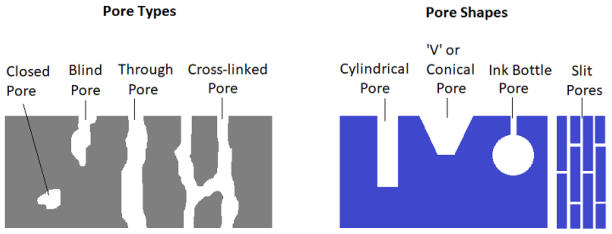




Expertise in the Physical
Characterisation of Materials

MCA Services
Unit 1A Long Barn, North End, Meldreth, Cambridgeshire SG8 6NT UK
01763 262333
© MCA Services





Porosimetry
Porosimetry
is
the
analysis
of
materials
in
order
to
understand
and
determine
their
porous
characteristics.
Porosimetry
can
provide
numerical
values
of
pore
volume,
pore
size
and
pore
area,
together
with
additional
information
such
as
surface
area,
bulk
density
and
volume
porosity.
It
is
also possible to determine pore size, pore area and pore volume distributions, often through graphical plots.
Pore
sizes
are
usually
divided
into
three
ranges,
micro-pores
(<2
nm),
meso-pores
(2
–
50
nm)
and
macro-pores
(>50
nm)
–
these
sizes
are
the
diameter of a cylindric
al pore or the width of a slit shaped pore according to IUPAC definitions.

There
is
no
single
technique
that
can
be
used
to
determine
porous
characteristics
throughout
the
three
size
ranges.
Therefore,
it
is
usually
necessary
to
select
the
most
appropriate
technique
for
a
given
sample
or
use
a
combination
of
techniques.
At
MCA
Services
we
have
decades
of
experience in this an
d are always happy to provide our thoughts on the selection of analysis techniques.
Meso-pores and macro-pores.
Mercury Porosimetry for the pore size range 3nm to ~ 650 µm
Mercury
porosimetry
is
used
for
the
characterisation
of
pores
from
3
nm
(0.003
µm)
up
to
approximately
650
µm
(0.65
mm),
although
the
upper
limit does depend on the physical nature of the sample being analysed. The following information can be obtained:
•
Pore Volume (numerical value and distribution)
•
Pore Area (numerical value and distribution)
•
Pore size (numerical value and distribution)
•
Bulk (Envelope) Density
•
Skeletal Density
•
Volume Porosity
•
Permeability
•
Tortuosity
Meso-pore and small macro-pore.
Gas Adsorption for the pores size range 2nm to ~ 300 nm
Gas
adsorption,
usually
using
nitrogen
at
77K,
is
used
for
the
characterisation
of
pores
from
3
nm
up
to
approximately
300
nm,
although
the
upper
limit
does
depend
on
the
gas
adsorption
characteristics
of
the
sample
being
analysed
and
may
be
higher
or
lower
than
this.
The
following
information can be obtained:
•
Pore Volume (numerical value and distribution)
•
Pore Area (numerical value and distribution)
•
Pore Size (numerical value and distribution)
•
Indication of pore geometry from desorption analysis
•
BET Surface Area
•
Statistical estimate of micro-pore volume
•
Choice of adsorptive
Micro-pores.
Micro-pore Gas Adsorption for pores < 2nm
Micro-pores
are
characterised
via
gas
adsorption
using
dedicated
instrumentation
with
uprated
vacuum
and
pressure
measurement
systems.
Nitrogen
adsorption
can
be
used
to
characterise
pores
>
0.5
nm
whilst
for
pores
<
0.5
nm
careful
selection
of
the
adsorptive
must
be
made,
for
example CO2 or Ar (at 77K or 87K). The following information can be obtained:
•
Pore Volume (numerical value and distribution)
•
Pore Area (numerical value and distribution)
•
Pore Size (numerical value and distribution)
•
Choice of adsorptive (N2, Ar, CO2, H2, O2 etc)
•
Micro-, meso- and small macro-pore characterisation in a single analysis
•
Extension of N2 data through combination with CO2 data
More
information
can
be
found
on
our
specific
Analytical
Options
pages
and
at
MCA
we
are
happy
to
discuss
particular
requirements
and
sample types to determine the most appropriate analytical technique or combination of techniques.





Expertise in the Physical
Characterisation of Materials
MCA Services
Unit 1A Long Barn, North End,
Meldreth, Cambridgeshire SG8 6NT UK
01763 262333
© MCA Services





Meso-pores and macro-pores.
Mercury Porosimetry for the pore size range 3nm to ~ 650 µm
Mercury porosimetry is used for the characterisation of pores from 3
nm (0.003 µm) up to approximately 650 µm (0.65 mm), although the
upper limit does depend on the physical nature of the sample being
analysed. The following information can be obtained:
•
Pore Volume (numerical value and distribution)
•
Pore Area (numerical value and distribution)
•
Pore size (numerical value and distribution)
•
Bulk (Envelope) Density
•
Skeletal Density
•
Volume Porosity
•
Permeability
•
Tortuosity
Meso-pore and small macro-pore.
Gas Adsorption for the pores size range 2nm to ~ 300 nm
Gas adsorption, usually using nitrogen at 77K, is used for the
characterisation of pores from 3 nm up to approximately 300 nm,
although the upper limit does depend on the gas adsorption
characteristics of the sample being analysed and may be higher or
lower than this. The following information can be obtained:
•
Pore Volume (numerical value and distribution)
•
Pore Area (numerical value and distribution)
•
Pore Size (numerical value and distribution)
•
Indication of pore geometry from desorption analysis
•
BET Surface Area
•
Statistical estimate of micro-pore volume
•
Choice of adsorptive
Micro-pores.
Micro-pore Gas Adsorption for pores < 2nm
Micro-pores are characterised via gas adsorption using dedicated
instrumentation with uprated vacuum and pressure measurement
systems. Nitrogen adsorption can be used to characterise pores > 0.5
nm whilst for pores < 0.5 nm careful selection of the adsorptive must
be made, for example CO2 or Ar (at 77K or 87K). The following
information can be obtained:
•
Pore Volume (numerical value and distribution)
•
Pore Area (numerical value and distribution)
•
Pore Size (numerical value and distribution)
•
Choice of adsorptive (N2, Ar, CO2, H2, O2 etc)
•
Micro-, meso- and small macro-pore characterisation in a single
analysis
•
Extension of N2 data through combination with CO2 data
More information can be found on our specific Analytical Options
pages and at MCA we are happy to discuss particular requirements and
sample types to determine the most appropriate analytical technique
or combination of techniques.


01763262333
POROSIMETRY
Porosimetry
is
the
analysis
of
materials
in
order
to
understand
and
determine
their
porous
characteristics.
Porosimetry
can
provide
numerical
values
of
pore
volume,
pore
size
and
pore
area,
together
with
additional
information
such
as
surface
area,
bulk
density
and
volume
porosity.
It
is
also
possible
to
determine
pore
size,
pore
area
and
pore
volume distributions, often through graphical plots.
Pore
sizes
are
usually
divided
into
three
ranges,
micro-pores
(<2
nm),
meso-pores
(2
–
50
nm)
and
macro-pores
(>50
nm)
–
these
sizes
are
the
diameter
of
a
cylindrical
pore
or
the
width
of
a
slit
shaped
pore
accordin
g to IUPAC definitions.

There
is
no
single
technique
that
can
be
used
to
determine
porous
characteristics
throughout
the
three
size
ranges.
Therefore,
it
is
usually
necessary
to
select
the
most
appropriate
technique
for
a
given
sample
or
use
a
combination
of
techniques.
At
MCA
Services
we
have
decades
of
experience
in
this
and
are
always
happy
to
provide
our
thoughts
on
the selection of analysis techniques.





















